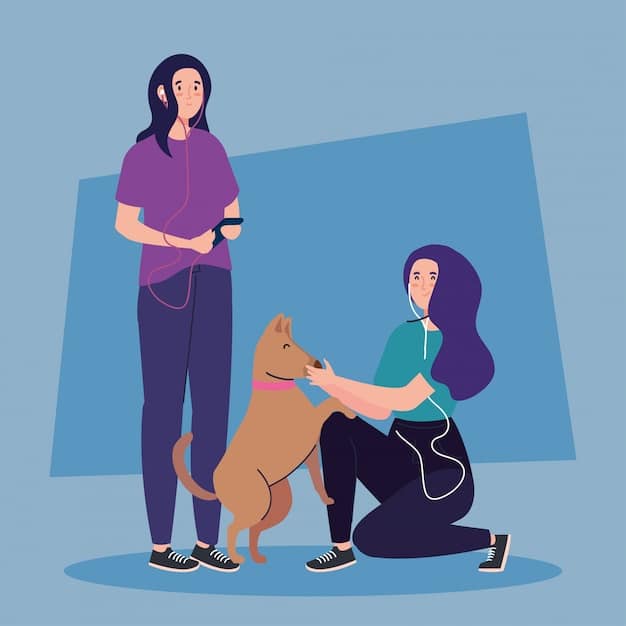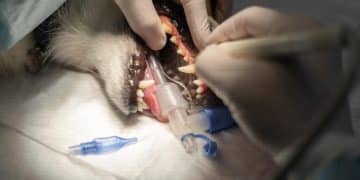First Aid for Pets: 5 Essential Skills for Owners in 2025

First aid for pets involves critical skills like CPR, controlling bleeding, and recognizing emergencies to provide immediate care until professional veterinary help is available.
Being a pet owner is a joy, but it also comes with responsibilities, including being prepared for emergencies. Knowing First Aid for Pets: 5 Critical Skills Every Owner Should Know can make the difference between life and death for your beloved companion.
Pet First Aid: Why Every Owner Needs to Know It
Accidents happen. Whether it’s a sudden allergic reaction, a minor wound from playtime, or something more serious, being equipped with basic pet first aid knowledge is crucial. This knowledge empowers you to provide immediate assistance and stabilize your pet until you can reach veterinary care.
Pet first aid goes beyond just bandaging a wound. It’s about understanding your pet’s vital signs, recognizing emergency situations, and knowing how to react calmly and effectively. Let’s explore why these skills are indispensable for every responsible pet parent.
Preparedness Saves Lives
Imagine your dog gets stung by a bee and has a severe allergic reaction. Knowing how to administer epinephrine (if prescribed by your vet) or recognizing the signs of anaphylactic shock can buy valuable time. Preparedness isn’t just about having a first-aid kit; it’s about knowing how to use it.
Reduces Anxiety for You and Your Pet
When an emergency strikes, panic can worsen the situation. Having a solid understanding of pet first aid techniques allows you to remain calm and focused, providing a sense of security for both you and your furry friend. Your calm demeanor can help alleviate your pet’s distress.

In conclusion, knowing pet first aid is an essential aspect of responsible pet ownership. It can save lives, reduce anxiety, and provide peace of mind knowing that you’re prepared to handle emergencies effectively. It empowers you to act quickly and confidently when your pet needs you most.
Skill #1: Mastering Basic Pet CPR
Cardiopulmonary resuscitation (CPR) is a life-saving technique that can restore breathing and circulation in pets experiencing cardiac or respiratory arrest. While it’s ideal to learn this skill hands-on through a certified pet CPR course, understanding the basics can provide a fighting chance until you reach a vet.
Pet CPR differs slightly from human CPR, primarily due to the anatomy of animals. It’s crucial to know the correct techniques for your specific type of pet, whether it’s a dog, cat, or even a smaller animal like a rabbit.
Assessing the Situation
Before starting CPR, ensure your pet is unresponsive and not breathing. Check for a pulse, ideally in the femoral artery (inside the upper thigh). If there’s no pulse and no breathing, it’s time to begin CPR. Be aware of your surroundings and move your pet to a safe location.
Performing Chest Compressions
Place your pet on their side on a firm surface. For dogs, chest compressions are typically performed over the widest part of the chest. For cats and smaller dogs, you can use one hand around the chest or two thumbs directly over the heart. Compress the chest about 1/3 to 1/2 of its width at a rate of 100-120 compressions per minute.
- Hand Placement: Know where to place your hands or thumbs for effective compressions.
- Compression Depth: Compress deeply enough to circulate blood, but not so hard that you cause injury.
- Compression Rate: Maintain a consistent rate of 100-120 compressions per minute.
CPR is a challenging skill, but mastering the basics can significantly increase your pet’s chance of survival. Practice proper hand placement, compression depth, and breathing techniques to prepare yourself for an emergency.
Skill #2: Controlling Bleeding in Pets
Bleeding is a common emergency in pets, often resulting from cuts, bite wounds, or accidents. Knowing how to control bleeding effectively is crucial to prevent significant blood loss and stabilize your pet until you can seek veterinary care.
The approach to controlling bleeding depends on the severity and location of the wound. Minor cuts may only require cleaning and direct pressure, while more severe wounds may require additional measures to stop the bleeding.
Applying Direct Pressure
For most bleeding wounds, applying direct pressure is the first and most important step. Use a clean cloth or gauze pad and press firmly over the wound. Maintain constant pressure for several minutes without lifting to allow a clot to form. If the blood soaks through the cloth, apply another one on top without removing the first.
Using a Tourniquet (If Necessary)
A tourniquet should only be used as a last resort for severe bleeding in a limb that cannot be controlled with direct pressure. It should be placed above the wound, as close to the body as possible. Tighten the tourniquet until the bleeding stops, and mark the time it was applied. Tourniquets can cause tissue damage if left in place for too long, so it’s crucial to seek veterinary care immediately.
- Direct Pressure First: Always try direct pressure before resorting to a tourniquet.
- Proper Placement: Ensure the tourniquet is placed correctly to be effective without causing further harm.
- Veterinary Care: Seek veterinary care immediately after applying a tourniquet.
Effectively controlling bleeding is a critical first aid skill that can significantly impact your pet’s outcome. By knowing when and how to apply direct pressure and when a tourniquet is necessary, you’ll be better prepared to handle these emergencies.
Skill #3: Recognizing Signs of Choking and Responding
Choking is a terrifying situation for any pet owner. Pets, especially dogs, often ingest objects that can become lodged in their throats. Recognizing the signs of choking and knowing how to respond quickly can save your pet’s life.
The Heimlich maneuver is a valuable technique for dislodging objects from a pet’s airway. However, the method varies slightly depending on the size and type of pet. It’s vital to understand the proper technique for your specific animal.
Identifying a Choking Pet
Signs of choking in pets include: struggling to breathe, excessive drooling, pawing at the mouth, blue-tinged gums (cyanosis), and panicked behavior. Your pet may also make gagging sounds or be unable to bark or meow.
Performing the Heimlich Maneuver
For dogs, if you can’t see the object, lift the dog’s hind legs into the air, similar to a wheelbarrow, and shake vigorously. Gravity might help dislodge the object. If that doesn’t work, perform abdominal thrusts: place your fist just behind the rib cage and push upward and forward. For smaller pets like cats, hold them with their back against your chest and use your fingers to perform gentle abdominal thrusts.

- Stay Calm: Your pet will sense your panic, so try to remain calm and focused.
- Check the Mouth: If possible, carefully open your pet’s mouth and look for the object. Do not attempt to blindly remove it, as you could push it further down.
- Seek Veterinary Care: Even if you successfully dislodge the object, seek veterinary care to ensure there are no further complications.
Knowing how to recognize the signs of choking and perform the Heimlich maneuver can dramatically improve your pet’s chances of survival. Quick, decisive action is key in these critical situations.
Skill #4: Managing Heatstroke and Hypothermia
Heatstroke and hypothermia are both temperature-related emergencies that can be life-threatening to pets. Understanding the signs of each condition and how to respond appropriately is crucial for protecting your pet’s well-being.
Heatstroke occurs when a pet’s body temperature rises to dangerous levels, often due to exposure to high temperatures or excessive exercise. Hypothermia, on the other hand, is a condition where a pet’s body temperature drops too low, usually due to prolonged exposure to cold environments.
Recognizing Heatstroke
Signs of heatstroke include: excessive panting, rapid heartbeat, drooling, weakness, vomiting, diarrhea, and collapse. In severe cases, your pet may experience seizures or coma.
When managing heatstroke, move your pet to a cool area, preferably with air conditioning. Offer small amounts of cool water (not ice water) to drink. Apply cool (not cold) water to their body, focusing on the groin, armpits, and paws. Seek veterinary care immediately.
Recognizing Hypothermia
Signs of hypothermia include: shivering, weakness, lethargy, slow heartbeat, and shallow breathing. Their gums may also be pale or blue.
- Cooling Techniques: Know the proper techniques to cool down a pet suffering from heatstroke.
- Warming Techniques: Understand how to safely warm up a pet experiencing hypothermia.
- Veterinary Care: In both cases, immediate veterinary care is essential to prevent life-threatening complications.
Being able to recognize and manage heatstroke and hypothermia is an essential part of responsible pet care. By understanding the signs and taking quick action, you can help protect your pet from these dangerous conditions.
Skill #5: Assembling and Knowing Your Pet First Aid Kit
Having a well-stocked pet first aid kit is essential for handling emergencies at home or on the go. Knowing what to include in your kit and how to use each item can make a significant difference in providing immediate care to your pet.
A comprehensive pet first aid kit should include items for wound care, bleeding control, basic examination, and other common emergencies. Tailor your kit to your pet’s specific needs and activities. For example, if you frequently hike with your dog, include items for snake bites or paw injuries.
Essential Items for Your Kit
Some essential items to include in your pet first aid kit are: antiseptic wipes, gauze pads, bandages (self-adhesive), medical tape, blunt-nosed scissors, a digital thermometer, disposable gloves, a towel, a syringe (for administering oral medications or flushing wounds), and a copy of your pet’s medical records.
Knowing How to Use Each Item
It’s not enough to just have a kit; you must know how to use each item effectively. Take a pet first aid course to learn how to properly bandage a wound, take your pet’s temperature, and administer medications. Practice using the items in your kit so you’re prepared in an emergency.
- Regularly Check Your Kit: Ensure all items are in good condition and not expired.
- Keep it Accessible: Store your kit in a location that’s easy to access in an emergency, both at home and when traveling.
- Customize Your Kit: Tailor your kit to your pet’s specific needs and lifestyle.
Assembling and maintaining a well-stocked pet first aid kit is a crucial step in responsible pet ownership. By knowing what to include and how to use each item, you’ll be better prepared to handle emergencies and provide immediate care to your furry friend.
| Key Point | Brief Description |
|---|---|
| 🫀 CPR Basics | Learn chest compressions and rescue breathing techniques. |
| 🩸 Stop Bleeding | Apply direct pressure to wounds; use tourniquet as last resort. |
| ⚠️ Choking Help | Recognize choking signs and perform the Heimlich maneuver. |
| 🌡️ Temp Control | Manage heatstroke with cooling and hypothermia with warming. |
FAQ
▼
Critical signs include difficulty breathing, severe bleeding, unresponsiveness, seizures, or signs of extreme pain. Any of these warrant immediate veterinary attention.
▼
Signs include struggling to breathe, gagging, pawing at the mouth, or blue-tinged gums. Act quickly if you observe these symptoms.
▼
Include gauze, bandages, antiseptic wipes, medical tape, scissors, a thermometer, disposable gloves, and your pet’s medical records.
▼
Check your kit every 3-6 months to ensure items haven’t expired and are in good condition for immediate use.
▼
Consider taking a certified pet first aid course offered by organizations like the American Red Cross or local veterinary clinics.
Conclusion
Equipping yourself with these five critical first aid skills is an investment in your pet’s health and safety. By being prepared, you can confidently handle emergencies and provide the best possible care for your beloved companion.





